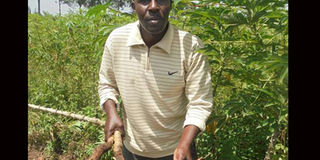From chips to flour, cassava offers a lot

Kelly Munema in his cassava farm in Kehancha, Kuria. Mr Munema harvests over 100 bags of cassava and has several options on how to make money from the crop. PHOTO | VIVERE NANDIEMO | NATION MEDIA GROUP
What you need to know:
- Many people think they can only make ugali out of cassava but one gets mandazis, cakes,crisps, chips and chapati as well, according to Booker Oloo, an agricultural officer.
- Cassava is rarely attacked by pests.
- Young cassava leaves are a source vitamin K.
- Cassava can be used to make mandazis, cakes, crisps, chips, chapati and biscuits too.
Namba is a sleepy hamlet about 2km from Kehancha town on the newly tarmacked Migori-Masaba route in Migori County. The outpost is mainly known for gold mining practised by scores of young men and women.
Farming is another vibrant activity here, but not preferred by many young people.
Kelly Munema is among the few who have taken to farming and his 15-acre farm hosts cassavas, and other crops like maize, eggplants, soy beans and sweet potatoes.
Cassava is one of his most profitable crops as he adds value to the produce. The crop sits on two acres and he harvests over 100 100kg bags of dried cassava, with a kilo going for Sh30.
“Some traders from Migori come to buy the tubers fresh from the farm. They sell to people who boil and eat.”
The farmer further makes flour from cassava for more income. “I hire a grinding machine from a friend in Kehancha at Sh2,000. I then sell the flour at Sh100 per kilo,” says Munema.
He slices the harvested tubers into smaller parts of, say, 5cm each, dries for two to three weeks and, thereafter, grinds into flour which is used to prepare meals like ugali, doughnuts and porridge. It can be used to make crisps and biscuits too.
Scores of farmers in the region shy away from growing cassava because it takes long to mature, but for Munema, the crop brings good fortune.
“I grow cassava and forget it for eight months as I concentrate on other crops. Cassava is rarely attacked by pests too.”
According to Munema, cassava requires a well-prepared land and good seeds. A lot of weeding should be done at the initial stages of planting and the crop is drought-resistant.
INVEST IN QUALITY SEEDS
The farmer grows cuttings from the stems of recently harvested plants.
“I cut 8 inches from the bottom of the stem then slice 10-inch cuttings. I then plant the cuttings every 3 feet in rows that are 3 feet apart.
If the soil is dry, the cuttings are planted at 45-degree angle. If the soil is wet, they are planted vertically.”
To harvest, the stem is cut, leaving a stub as a handle to pull the cassava roots out of the ground.
His major challenge is the short post-harvest shelf-life of the freshly harvested cassava.
Cassava does well in well-drained sandy loam soils with a pH of between 5.5 to 6.5. It thrives in a temperature of between 250C to 320C and rainfall of between 1,000-1,500mm. However, the crop can survive in dry conditions making it suitable for arid and semi-arid areas.
To defeat the deadly cassava brown streak mosaic disease, the farmer says one should invest in quality seeds.
“When I was beginning, I used Sh6,000 to buy the improved cassava variety nodes from Kenya Agricultural and Livestock Research Organisation.
This variety, which is called Tajirika, matures in eight months and has a root yield of 25 tonnes per acre.”
Kuria East sub county agricultural officer Booker Washington Oloo says cassava is one of the most versatile crops. “Many people think they can only make ugali out of it but one gets mandazis, cakes, crisps, chips and chapati as well. Cassava leaves also make delicious vegetables.”
The Rockefeller Foundation is currently working on a project to increase the shelf-life of cassava, according to its Managing Director for Africa Mamadou Biteye.
Its success, Biteye says, will boost the earnings of farmers such as Munema.





